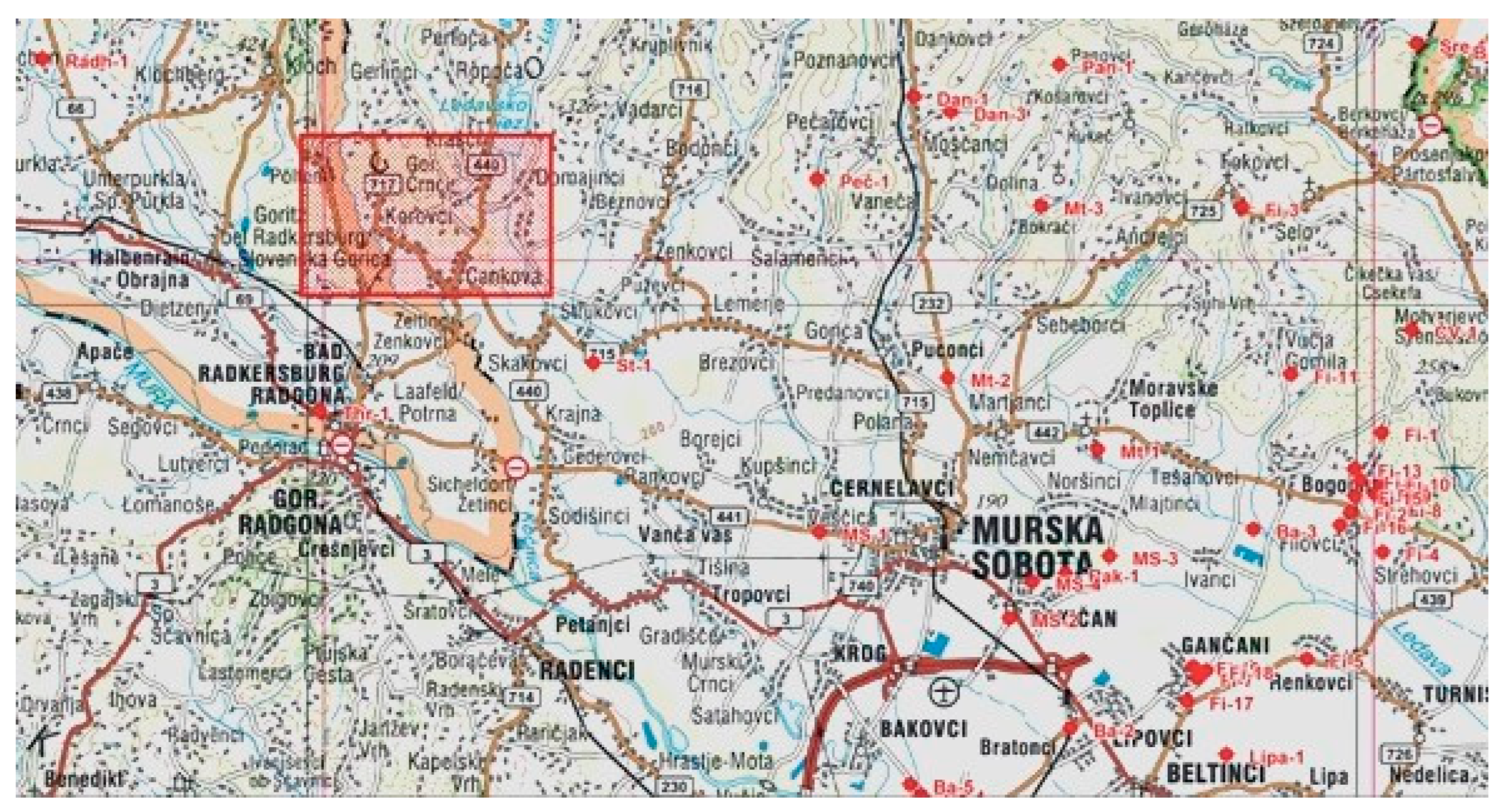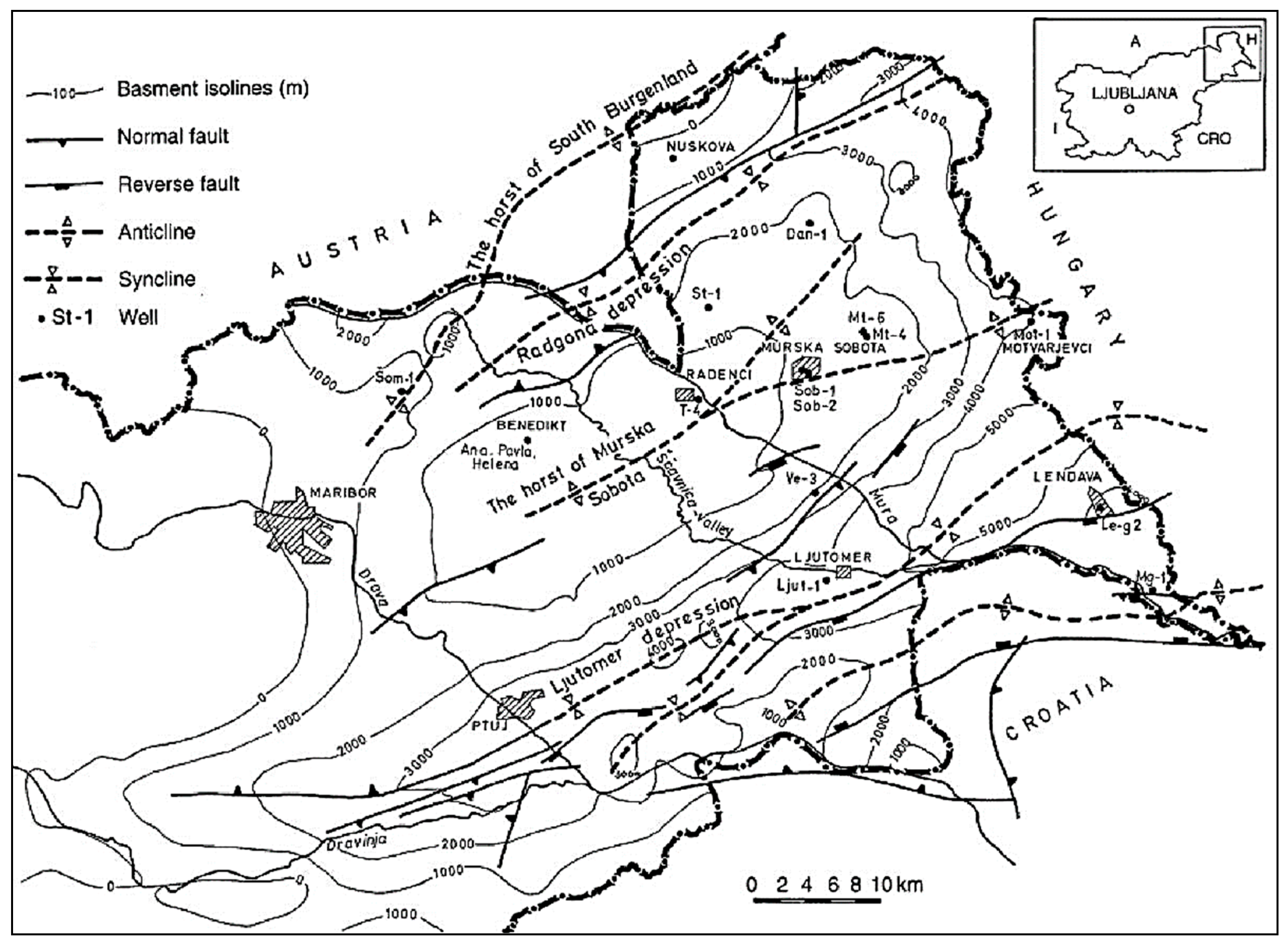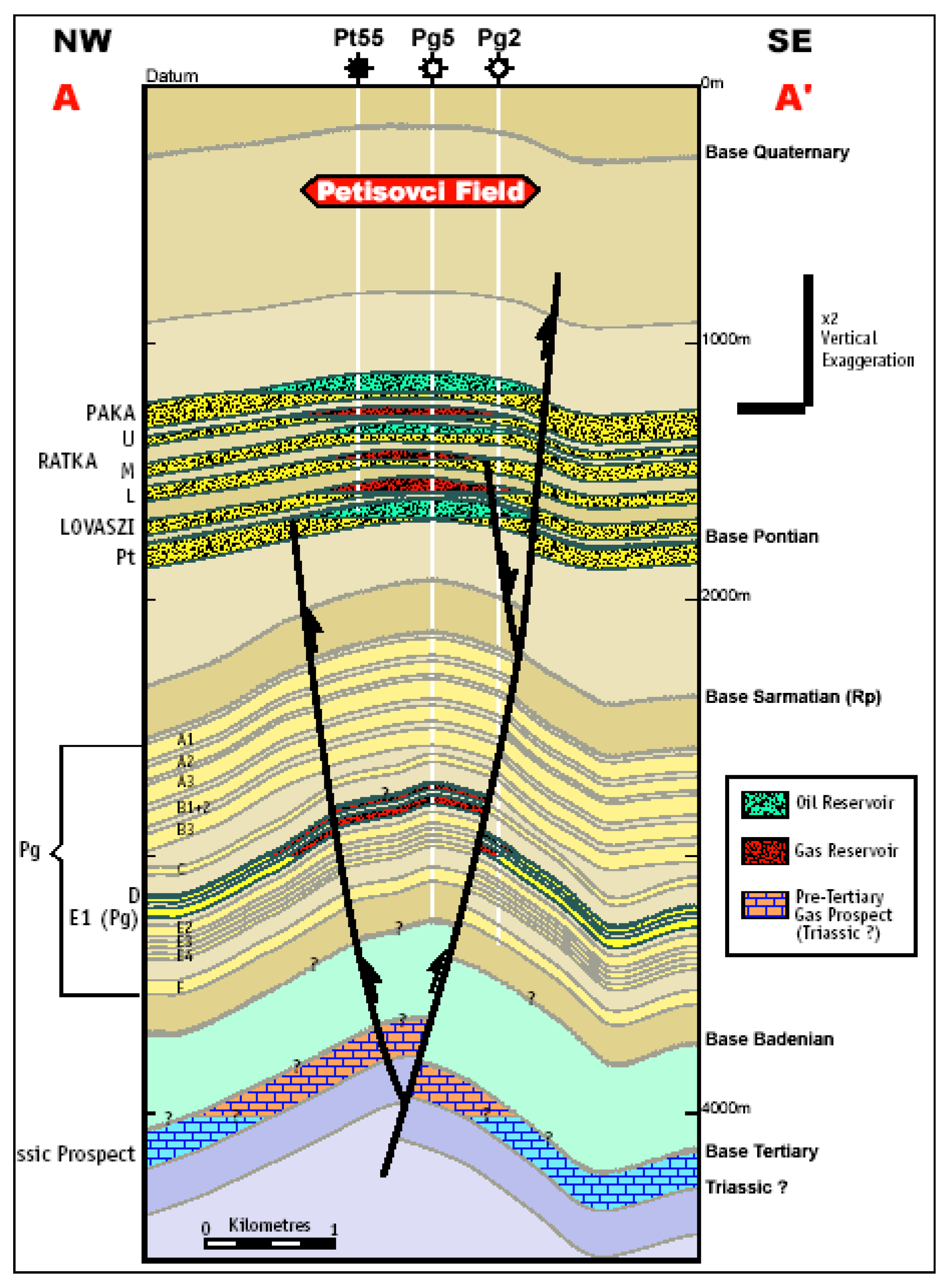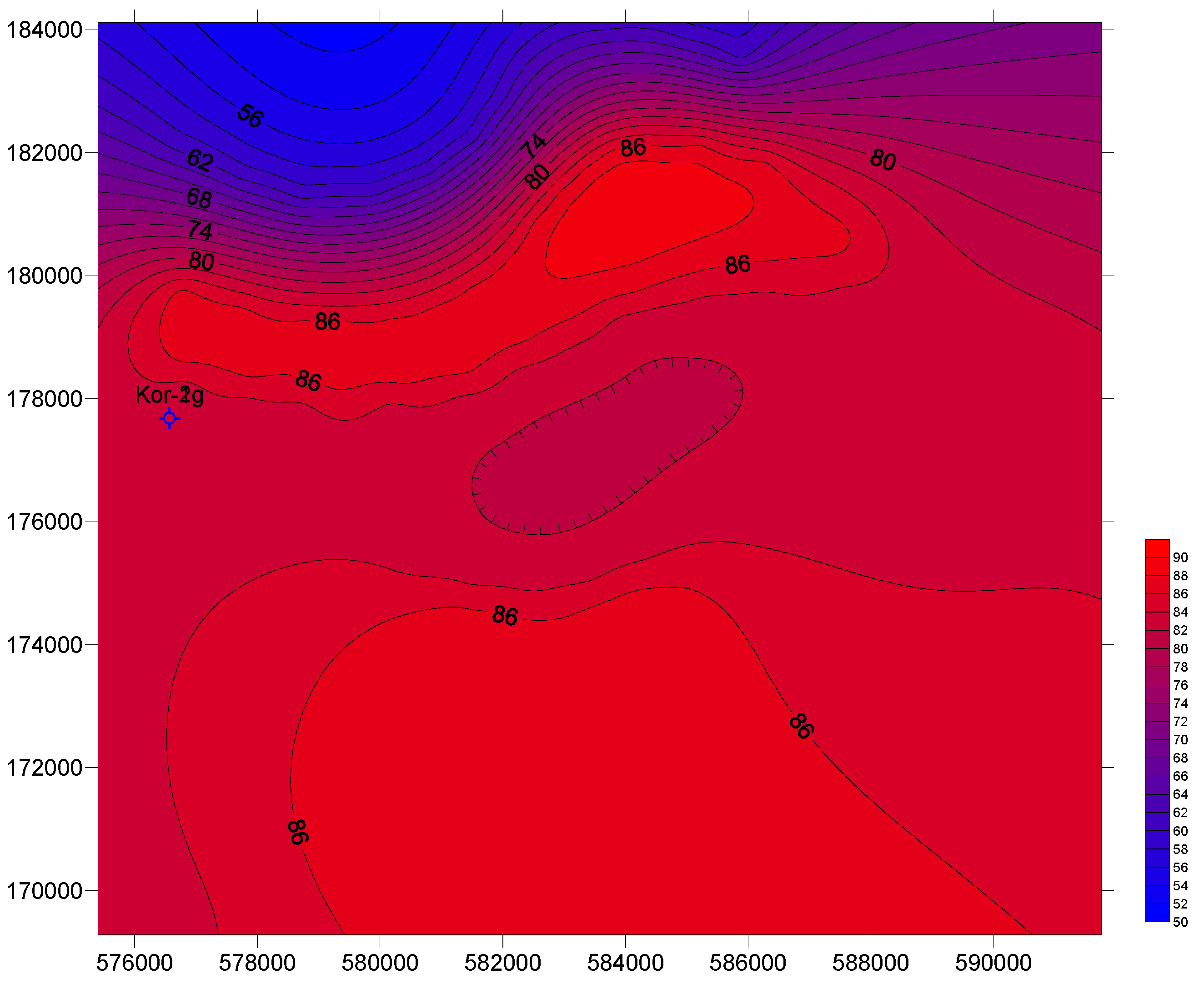Geothermal Potential of Pumping–Injecting Doublet Wells
Abstract
1. Introduction
2. Materials and Methods
2.1. Geographical Overview
2.2. Geological Overview
- The Maribor–Radgonje Depression;
- The Murska Sobota Massif;
- The Ptuj–Ljutomer Depression;
- The Ormož–Selniška Anticline.
2.3. Hydrogeological Situation
2.4. Geothermal Situation
3. Results
- To determine whether our pumping and pouring in any way affects the pumping on the Austrian side;
- To ascertain the possible influences of pumping wells in the Austrian Gornja Radgona;
- To evaluate the influence of the pumping–injection pair on the temperature field in the water carrier.
4. Conclusions
Author Contributions
Funding
Data Availability Statement
Conflicts of Interest
References
- Rman, N.; Gál, N.; Marcin, D.; Weilbold, J.; Schubert, G.; Lapanje, A.; Rajver, D.; Benkova, K.; Nádor, A. Potentials of transboundary thermal water resources in the western part of the Pannonian Basin. Geothermics 2015, 66, 88–98. [Google Scholar] [CrossRef]
- Rajver, D. Map of Surface Heat-Flow Density. Geological Atlas of Slovenia, 2nd ed.; Geological Survey of Slovenia: Ljubljana, Slovenia, 2016. [Google Scholar]
- Brilly, M. Matematični Model Za Simulacijo Toka Podtalnice Mursko-Ljutomerskega Polja; FAGG, Laboratorij Za Mehaniko Tekočin: Ljubljana, Slovenia, 1983. [Google Scholar]
- Available online: https://meteo.arso.gov.si/uploads/probase/www/climate/table/sl/by_location/murska-sobota/climate-normals_71-00_murska-sobota.pdf (accessed on 12 January 2024).
- Tóth, G.; Rman, N.; Rotár-Szalkai, Á.; Kerékgyártó, T.; Szőcs, T.; Lapanje, A.; Černák, R.; Remsík, A.; Schubert, G.; Nádorm, A. Transboundary fresh and thermal groundwater flows in the west part of the Pannonian Basin. Renew. Sustain. Energy Rev. 2016, 57, 439–454. [Google Scholar] [CrossRef]
- Rman, N.; Lapanje, A.; Rajver, D. Analysis of thermal water utilization in the northeastern Slovenia. Geologija 2012, 55, 225–242. [Google Scholar] [CrossRef]
- Prestor, J.; Rman, N.; Lapanje, A.; Szőcs, T. Benchmarking—Sustainability of Thermal Groundwater Management; GeoZS: Ljubljana, Slovenia; SGUDS: Bratislava, Slovakia; MFGI: Budapest, Hungary; GBA: Wien, Austria, 2013. [Google Scholar]
- Kaluđerović, D.; Vižintin, G. Modflow USG—The next step in mathematical modelling of underground water. RMZ-Mater. Geoenviron. 2014, 4, 241–247. [Google Scholar]
- Kralj, P.; Kralj, P. Thermal and Mineral Waters in North-Eastern Slovenia. Environ. Geol. 2000, 39, 488–500. [Google Scholar] [CrossRef]
- Doorenval, H.; Elmers, C.; Parker, N.; Veld, H.; Van Bergen, F. Petišovci Pre-Tertiary Carbonates; Netherlands Institute of Applied Geoscience TNO—National Geological Survey: Amsterdam, The Netherland, 2000. [Google Scholar]
- Vižintin, G.; Vukelič, Ž.; Vulić, M. Monitoring the geothermal potential of deep tertiary aquifers in north-east Slovenia using old abandoned oil and gas wells. Mod. Tendencies Dev. Energy Min. Proc. 2008, 39–52. [Google Scholar]
- Domenico, P.A.; Schwartz, F.W. Physical and Chemical Hydrogeology; John Wiley & Sons: New York, NY, USA, 1990. [Google Scholar]
- Friðleifsson, G.O.; Elders, W.A.; Albertsson, A. The concept of the Iceland deep drilling project. Geothermics 2014, 49, 2–8. [Google Scholar] [CrossRef]
- Lund, J.W.; Boyd, T.L. Direct utilization of geothermal energy 2015 Worldwide review. Geothermics 2016, 60, 66–93. [Google Scholar] [CrossRef]
- Dipippo, R. Geothermal power plants: Evolution and performance assessments. Geothermics 2015, 53, 291–307. [Google Scholar] [CrossRef]
- Vižintin, G. Hidrogeološko Poročilo Za Pridobitev Koncesije Terme Lendava; HGEM d.o.o: Ljubljana, Slovenia, 2005. [Google Scholar]
- Dovenyi, P.; Horvath, F.; Liebe, P.; Galfi, J.; Erki, I. Geothermal conditions of Hungary. Geophys. Trans. 1983, 29, 3–114. [Google Scholar]
- Ravnik, D. Geotermične raziskave v Sloveniji = Geothermal investigations in Slovenia. Geologja 1991, 34, 265–303. (In Slovene) [Google Scholar] [CrossRef]
- Lenkey, L.; Dovenyi, P.; Horvath, F.; Cloetingh, P.L. Geothermics of the Pannonian basin and its bearing on the neotectonics. EGU Stephan Muller Spec. Publ. Ser. 2002, 3, 29–40. [Google Scholar] [CrossRef]
- Rajver, D.; Ravnik, D. Geotermična slika Slovenije razširjena baza podatkov in izboljšane geotermične karte—Geothermal pattern of Slovenia–enlarged database and improved geothermal maps. Geologija 2002, 45, 519–524. (In Slovene) [Google Scholar] [CrossRef]
- Nádor, A.; Lapanje, A.; Tóth, G.; Rman, N.; Szőcs, T.; Prestor, J.; Uhrin, A.; Rajver, D.; Fodor, L.; Muráti, J.; et al. Transboundary geothermal resources of the Mura-Zala basin: A need for joint thermal aquifer management of Slovenia and Hungary—Čezmejni geotermalni viri Mursko-Zalskega bazena: Potreba po skupnem upravljanju geotermalnih vodonosnikov Slovenije in Madžarske. Geologija 2012, 55, 209–223. [Google Scholar] [CrossRef]
- Marko, A.; Mádl-Szőnyi, J.; Brehme, M. Injection related issues of a doublet system in a sandstone aquifer—A generalized concept to understand and avoid problem sources in geothermal systems. Geothermics 2021, 97, 102234. [Google Scholar] [CrossRef]
- Reinsch, T.; Dobson, P.; Asanuma, H.; Huenges, E.; Poletto, F.; Sanjuan, B. Utilizing supercritical geothermal systems: A review of past ventures and ongoing research activities. Geotherm. Energy 2017, 5, 16. [Google Scholar] [CrossRef]
- Weber, J.; Schulz, R. Deep Geothermal Energy Production in Germany Thorsten Agemar. Energies 2014, 7, 4397–4416. [Google Scholar]
- Molina-Giraldo, N.; Bayer, P.; Blum, P. Evaluating the influence of thermal dispersion on temperature plumes from geothermal systems using analytical solutions. Int. J. Therm. Sci. 2011, 50, 1223–1231. [Google Scholar] [CrossRef]
- Liao, K.; Zhang, S.; Ma, X.; Zou, Y. Numerical investigation of fracture compressibility and uncertainty on water-loss and production performance in tight oil reservoirs. Energies 2019, 12, 3698. [Google Scholar] [CrossRef]
- Beckers, K.F.; Mccabe, K. Geophires v2.0: Updated geothermal techno-economic simulation tool. Geotherm. Energy 2019, 7, 5. [Google Scholar] [CrossRef]
- Le Lous, M.; Larroque, F.; Dupuy, A. Thermal performance of a deep borehole heat exchanger: Insights from a synthetic coupled heat and flow model. Geothermics 2015, 57, 157–172. [Google Scholar] [CrossRef]












| Model | Thickness (m) | K (m/s) | T (m2/s) | λs (W/mK) | (W/mK) | Cs (J/m3K) | (J/m3K) |
|---|---|---|---|---|---|---|---|
| 1 | 10 | 10−5 | 10−4 | 5.73 | 0.65 | 2.52 | 4.2 |
| 2 | 50 | 10−5 | 5 × 10−4 | 5.73 | 0.65 | 2.52 | 4.2 |
| 3 | 100 | 10−5 | 1 × 10−3 | 5.73 | 0.65 | 2.52 | 4.2 |
| 4 | 200 | 10−5 | 2 × 10−3 | 5.73 | 0.65 | 2.52 | 4.2 |
Disclaimer/Publisher’s Note: The statements, opinions and data contained in all publications are solely those of the individual author(s) and contributor(s) and not of MDPI and/or the editor(s). MDPI and/or the editor(s) disclaim responsibility for any injury to people or property resulting from any ideas, methods, instructions or products referred to in the content. |
© 2024 by the authors. Licensee MDPI, Basel, Switzerland. This article is an open access article distributed under the terms and conditions of the Creative Commons Attribution (CC BY) license (https://creativecommons.org/licenses/by/4.0/).
Share and Cite
Vižintin, G.; Šporin, J.; Vukelić, Ž. Geothermal Potential of Pumping–Injecting Doublet Wells. Energies 2024, 17, 980. https://doi.org/10.3390/en17050980
Vižintin G, Šporin J, Vukelić Ž. Geothermal Potential of Pumping–Injecting Doublet Wells. Energies. 2024; 17(5):980. https://doi.org/10.3390/en17050980
Chicago/Turabian StyleVižintin, Goran, Jurij Šporin, and Željko Vukelić. 2024. "Geothermal Potential of Pumping–Injecting Doublet Wells" Energies 17, no. 5: 980. https://doi.org/10.3390/en17050980
APA StyleVižintin, G., Šporin, J., & Vukelić, Ž. (2024). Geothermal Potential of Pumping–Injecting Doublet Wells. Energies, 17(5), 980. https://doi.org/10.3390/en17050980





